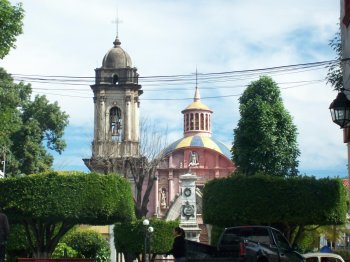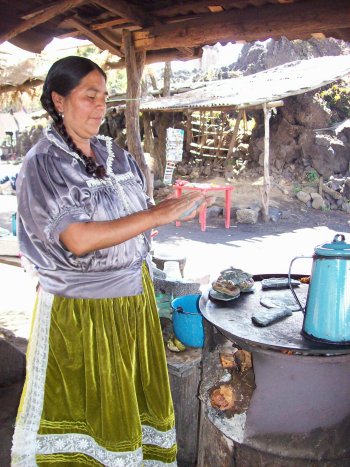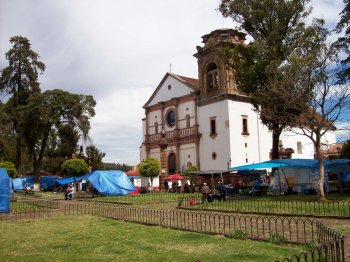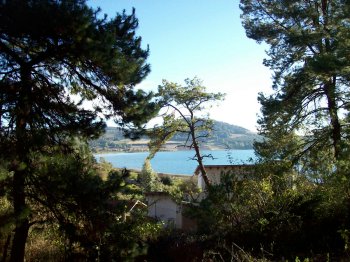 |
 |
 |
 |
 |
 |
 |
 |
 |
 |
 |
 |
 |
 |
 |
|
 |
|
|
|
Patzcuaro has a very different feel from Morelia. It's older, and is only about 10% of the size (~80,000 people). The streets are a mix of cobblestone and concrete, and the buildings are painted traditional white and red adobe brick with tile roofs.
We drove to their very large downtown tianguis and bought some fruit and a belt for Dave. We also stopped in on a former church that is now the town's library. The mural at the end was very impressive. |
|
|
|
 |
|
|
|
The same realtor who met us in Morelia met us at the Patzcuaro Basilica church, which is the main church in Patzcuaro. The fronting square was peppered with knickknack vendors, trash, and one overflowing rubbish bin. Sad.
She took us to a subdivision called Villas del Sol, which overlooks Patzcuaro center, Lake Patzcuaro and the surrounding
forested hills. The land is fairly steep, so we were enamored with the view. |
|
|
|
 |
|
|
|
We next visited Lake Zirahuen, about half an hour out of Patzcuaro. This would
be an average quality lake in a developed country, but here in Mexico this is the first lake we've seen that isn't severely polluted. Andrew went for a wade with the fishermen. We looked at
some bare land for sale on the way, but it was ejido (not private land). Overlooking the lake, we checked out a nice house for sale with 2,300 m
2 (24,757 ft2) of trees, and a
small 550 m2 (5,920 ft2) lot
next door. |
|
|
|
 |
|
|
|
Although the CS host was friendly enough, we didn't have a good sleep. We only got the broken double bed because the woman sleeping there spent the night driving a Ferrari on the highways
and partying with friends until 5 am. She visited twice during the night. We also shared the room with a self-proclaimed wanderer who is teaching English at O'Lenguas. The window was broken and noise
and dirt came in until the early hours. At least we ate some excellent tacos for dinner! |
|
|
|
 |
|
|
|
The road to the San Juan Parangaricutiro church was dusty with ash, rocky and steep in some places. Our poor Honda only made it by Dave's skillful off-road driving.
We spent a while at the ruins, including climbing down into a wing of the church through a former window. In there we could still see the remnants of fine plasterwork on the roof and patterns on the wall. The
church is seen as sacred by the relocated villagers (because it "survived" the eruptions) and they make a pilgrimage to the site once a year. Flowers, photos and cards are left in the former sacristy. The
forests and mountains in this area were beautiful, with one range even dusted with snow. |
|
|
|
 |
|
|
|
They showed us a few nice, clean rooms, including one with a view of the plaza. That one was booked however, so Andrew asked if there was another room similar to it. After a bit of
discussion, they showed us the "junior suite", which had a loft, king-sized bed, balcony, carved wooden poles and artwork, a fireplace (with firewood), and a larger bathroom with a deep tiled tub. They
gave us this room for the same $350 pesos! It normally rents for over $1000 pesos a night. We took it for two nights. |
|
|
|
 |
|
|
|
The first workshop we visited was a humble operation with a basic fireplace and tools. We bought a copper pan and a small brass bell. The next store we visited had much more
elaborate and detailed copper pieces, from huge copper bathtubs to intricate flowers. Their workshop in the backyard gave us an excellent display of how the copper is brought in, softened with fire, shaped with
heavy mallets (often many times), cooled, colored and a soft hammering to make it harder. All the pieces they were working on were to eventually be sold in their shop. The process was fascinating, better
than a museum, and they only had a tip jar for payment. In Santa Clara we also bought cute little salt and pepper shakers, and a simple copper flower with a small photo frame attached. |
|
|
 |
|
|
|
We took a boat trip to the island of Janitzio. It cost 40 pesos ($US 3.00) round-trip, each. The Purepecha people have lived on the island for centuries. In the past their livelihood was fishing using butterfly nets (which we saw from the boat on the way over), but now most income seems to come from tourism: food, accommodation and gauche souvenirs. And from the looks on their faces, the locals seem to resent this. |
|
|
|
 |
|
|
|
The entire town, so it seemed, marched from one end to the other carrying banners, crosses, and some sort of purple platform with a holy figure inside. We couldn't see exactly. In
Mexico, most towns have a town festival that lasts a week or more every year. We assume we happened to pass through Naranja's. It slowed our progress down considerably, but it was interesting to see. |
|
|
 |
 |
 |
 |
 |
 |
 |
 |
 |
 |
 |
 |
 |
 |
 |
 |
 |
|
As it was a Friday night, the locals were out in force in cafes, parks, plazas, the nice Artesanias museum, and so on. At 9 pm, the Catedral had a music, lights and fireworks show celebrating
Morelia. It was a nice way to see off the day, though we took the long way back to our car to see an old convent and other churches. The next day we took the new highway to Patzcuaro. It is free,
four-laned and very smooth. We got there in only 35 minutes. |
|
|
|
 |
|
|
|
We headed off to La Casa de los Once Patios (the house of the eleven squares). This was a 17th Century convent that has been converted into a center for craftspeople to sell their wares. The greater Patzcuaro area is famous for its crafts, particularly in copper, wood and ceramic. |
|
|
|
 |
|
|
|
Despite some killer topes (speed bumps) to get to the place (why oh why??) we really liked the place: central, all services, reasonable land prices, middle-class houses being built in
various styles, great views, existing mature trees, and decent-sized sections - for Mexico that is, 260 - 560 m2
(2,800 - 6,028 ft2) We're continuing discussions with the realtor, and will probably revisit the place if we decide to
move to Patzcuaro. |
|
|
|
 |
|
|
|
We drove another excellent fast 2 lane highway down to Uruapan, a toll road this time. Uruapan
is a town that does not reflect its surroundings. The forests and mountains are beautiful, but the town itself is ugly, noisy and congested. After half an hour working through central city streets, we met
our CouchSurfing host at the central square who guided us first to his language school O'Lenguas, then to his home. |
|
|
|
 |
|
|
|
We went to Uruapan's famous "National Park", but unfortunately pets were not allowed (along with weapons and drugs,
says the sign!) So after visiting a macadamia and avocado products shop and buying some nuts, we headed north into the hills to see Paricutin Volcano and a church buried by the eruptions.
Paricutin started as a fissure in 1943, and by 1951 it had grown 424 meters (1,391 feet) and buried the nearby village with lava and debris. Only portions of the church remain above ground. |
|
|
|
 |
|
|
|
On our way back to the parking lot, we ate quesadillas hand-made from blue corn, and filled with cheese, potatoes, beef and avocado. Delicious! Andrew also bought a very nice
hand-crafted necklace made with a rare stone. It and others were for sale for very reasonable prices on a rug at the side of the path. We decided to head back to Patzcuaro to have a full day there.
We were looking for a hotel costing about 350 pesos ($US 27.00) per night. We saw a sign for a hotel, and asked the price. It turned out that place was the parking lot for Hotel Los Escudos, a popular hotel overlooking the main plaza in Patzcuaro. So we drove to the hotel and had a look at the rooms. |
|
|
|
 |
|
|
|
The room was a welcome respite after our fitful sleep the night before. For dinner, we had a three course meal-of-the-day of traditional Michoacan fare at a nearby restaurant for 60 pesos
each ($US 4.60), excluding drinks. The next day for lunch we had a similar 3-course meal for 70 pesos each. We were woken in the morning by Mela, and also by drumming and trumpets playing. Our balcony was
just a few meters away from the flag-raising ceremony at the beginning of the week. The town of Santa Clara del Cobre was a must-see, for its hand-made copper crafts. It is only a short drive south from Patzcuaro. |
|
|
|
 |
|
|
|
Andrew visited CELEP - a not-for-profit language school two blocks from our hotel that raises money for environmental education around Lake Patzcuaro. They may have work for Andrew in the second half of the year, and private clients are referred to the teachers by the school.
Later that evening, we visited the dock area, shopped for coffee mugs and enjoyed the lakefront. |
|
|
|
 |
|
|
|
Not knowing how much time we had before the last boat left for the mainland, we quickly climbed the steps and streets to Morelos.
Jose Maria Morelos is a giant 40 meter (131 feet) statue on top of Janitzio Island, standing with a raised fist to proclaim independence. The stairs up inside the statue were locked for the night, so we
satisfied ourselves with a walk around, the view, and a very nice sunset. The following day we left our wonderful room and took the Libre (free road) north to Panindicuaro, where we joined the toll highway back to
Guadalajara. We passed by the circular Purepechan ruins at Tzintzuntzan (Dave's favorite place name this trip!). Thankfully we weren't short
on time, as in a small town called Naranja (Orange) on the Libre, we passed a major religious event. |
|
|
|
 |
|
|

